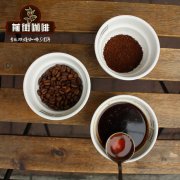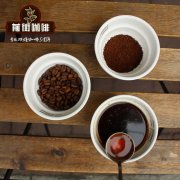The history and culture of coffee cultivation in Guatemala? The cultivation of coffee beans in dangerous countries?
The history and culture of coffee cultivation in Guatemala? What are the producing areas? The cultivation and spread of coffee beans in Guatemala?

The Republic of Guatemala (Spain: Rephost blica de Guatemala) is a country of Central America, located in the southern part of the North American Peninsula, bordering Mexico to the north, Celis to the north, Honduras to the south and Covado to the south. The capital Guatemala City is also the largest city in Guatemala at the same time. At present, by the end of 2014, the working population of Guatemala is mainly engaged in traditional agriculture, mainly exporting traditional agricultural products such as coffee, sugar and bananas.
From the 4th century to the 11th century, Guatemala was the center of ancient Indian elegant culture, and the ruins of many pyramids and cities left during this period are still visible today. This list introduces one of the four traditional ancient civilizations (for more information about the ancient civilization, please see the Yaya Civilization).
The Maya, born in 3113 BC, were ancient Indians living in Central America and disappeared in about 750 AD. The territory in which the Yas live includes the heart of Central America, spanning parts of the existing Guatemala (Guatemala), Suris, Mexico (Mexico), Honduras (Honduras) and El Salvador (Guatemala). The main population is concentrated in the low and low areas of present-day Guatemala's Peten province and Yucat'an.
The culture of elegant culture
In the 16th century, when the Spaniards invaded Central and South America, they destroyed all the ancient elegant cultural relics and sacred texts preserved by the Aztec, the descendants of the elegant civilization. People suffer from diseases such as smallpox and nuclear diseases. At that time, the bishops of Spain could not tolerate the fact that the Mayans did not believe in Christianity. So collect all the divine mantras on the hands of all the priests, and use fire to burn them all. This has led to the disappearance of many rare records of elegant civilization. Fortunately, there are still very few books that have not been recorded or passed down from generation to generation. At present, there are still descendants of ethnic minorities living in Central America, including Guatemala.
The traditional customs of the Yaya nationality
The traditional customs of the Yaya nationality
Guatemala is really committed to economic modernization is the United States-led fruit company (United Fruit Co.) And foreign companies such as subsidiaries of the United States and other national joint venture power companies (that is, Jinjin Guatemala Power Company). At that time, the fruit company (now renamed "Jinjida Brand International") became the largest banana grower and dealer in the United States, mainly from countries in Central America (more international information about the Jinjidah brand). The practice is to intervene in the politics of various countries and profit from China by collecting large amounts of coffee and banana cuisine from Guatemala and other Central American countries.
The high quality of Guatemalan coffee beans is due to the unique conditions of their production areas, including different climatic conditions in each region, rich soil formed by volcanoes, and abundant natural water resources. high-altitude mountains and high-tide forests. There are seven main producing areas in Guatemala: Antigua Coffee (Antigua Coffee), traditional Artitl á n (Traditional Atitl á n), Rainforest Coban á n (Rainforest Coban), Fraijanes Plateau, Mini Nanguo Highland (Highland Huehue), New Zealand (New Oriente), volcanic volcanoes.
Antigua coffee (Antigua Coffee):
Rich volcanic soil, low temperature, plenty of light and cool night are the characteristics of Antigua coffee producing area. The valley is surrounded by three volcanoes: Agua, Fuego and Acatenango. The Huodianhu volcano is one of the three most active volcanoes in the dangerous area. The ash from the volcano has made the soil of Antigua rich in mineral minerals. The volcanic pumice in the soil can maintain humidity and help overcome the lack of rainfall in Antigua. In addition, this area is particularly dense, which can withstand occasional frost and protect coffee plants from frost.
Pico Nanguo Highland (Highland Huehuetenengo):
Of the three major non-volcanic coffee producing areas in Guatemala, the Weitunango Highland is the driest and highest region of the climate. It comes from the dry climate of Mexico's Tehuantepec plateau, protecting the area's coffee from frost. Coffee can be grown to 2000 meters (6500 feet). Due to the poor location, all coffee bars have to process their own coffee. Fortunately, there are so many streams in the area that they can almost set up small processing stations.
Important Notice :
前街咖啡 FrontStreet Coffee has moved to new addredd:
FrontStreet Coffee Address: 315,Donghua East Road,GuangZhou
Tel:020 38364473
- Prev

What are the flavors and characteristics of the eight regions of Guatemala? What are the grades?
What are the flavors and characteristics of the eight regions of Guatemala? What are the grades? In 1750, Father Jesuit introduced coffee trees to Guatemala, where German colonists developed the coffee industry in the late 19th century. Today, most of the coffee industry is produced in the south of the country. Coffee in Guatemala Origin: Sierra Madre Fire
- Next

What are the flavor characteristics of the Saint Guava Manor in Farahannis, Guatemala?
What are the flavor characteristics of Pacamara, the San Guava Manor in Farahannis, Guatemala? The fifth place in COE in Guatemala, the Fraijanes volcano in the Fahannis region is quite high above sea level, and the soil is rich in pumice. The Farrakhan Plain is still an active volcanic area, so the coffee in this area is similar to that of Antigua. However, Rain Water is rich, tall and rich.
Related
- Detailed explanation of Jadeite planting Land in Panamanian Jadeite Manor introduction to the grading system of Jadeite competitive bidding, Red bid, Green bid and Rose Summer
- Story of Coffee planting in Brenka region of Costa Rica Stonehenge Manor anaerobic heavy honey treatment of flavor mouth
- What's on the barrel of Blue Mountain Coffee beans?
- Can American coffee also pull flowers? How to use hot American style to pull out a good-looking pattern?
- Can you make a cold extract with coffee beans? What is the right proportion for cold-extracted coffee formula?
- Indonesian PWN Gold Mandrine Coffee Origin Features Flavor How to Chong? Mandolin coffee is American.
- A brief introduction to the flavor characteristics of Brazilian yellow bourbon coffee beans
- What is the effect of different water quality on the flavor of cold-extracted coffee? What kind of water is best for brewing coffee?
- Why do you think of Rose Summer whenever you mention Panamanian coffee?
- Introduction to the characteristics of authentic blue mountain coffee bean producing areas? What is the CIB Coffee Authority in Jamaica?

